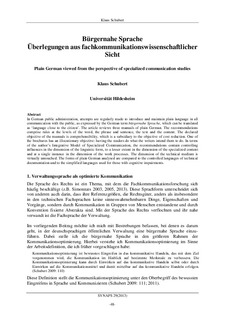| dc.description.abstract | In German public administration, attempts are regularly made to introduce and maintain plain language in all communication with the public, as expressed by the German term bürgernahe Sprache, which can be translated as ‘language close to the citizen’. The article reviews three manuals of plain German. The recommendations comprise rules at the levels of the word, the phrase and sentence, the text and the content. The declared objective of the manuals is comprehensibility, which is a subsidiary to the objective of cost reduction. One of the brochures has an illocutionary objective: having the readers do what the writers intend them to do. In terms of the author’s Integrative Model of Specialized Communication, the recommendations contain controlling influences in the dimension of the linguistic form, to a lesser extent in the dimension of the specialized content and at a single instance in the dimension of the work processes. The dimension of the technical medium is virtually untouched. The forms of plain German analysed are compared to the controlled languages of technical documentation and to the simplified languages used for those with cognitive impairments. | nb_NO |
